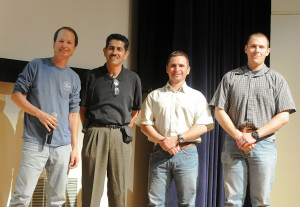“Most of us have dreamt as a kid–if we’re being honest–of finding a mammoth,” said anthropologist Timothy King ‘04 Ph.D. ‘06 to artichoke farmers Ryan and Martin Jefferson onstage at Cubberley Auditorium Thursday evening. “And what’s wonderful is that you guys did find it and you shared it with all of us.”
King is part of an extensive team that has uncovered about 30 to 40 percent of a Columbian mammoth found in Castroville, Calif., in Dec. 2010 by the Jefferson brothers. The brothers discovered the fossil in the fields of their farm after they found a strange rock that Martin Jefferson said he recognized as a mammoth tooth.

Sponsored by Stanford Continuing Studies, King and the Jeffersons came to Stanford to present on “The Castroville Mammoth Project,” along with site director Daniel Cearley and project illustrator Joshua Ballze.
Martin Jefferson said that after discovering the tooth, he contacted a friend working for the Natural Resources Conversation Service to begin bringing in people who would know what to do. It was his landlord’s daughter, however, who put him in touch with California State Parks archaeologist Mark Hylkema, who is the team project director. Hylkema then assembled a team to form the Castroville Mammoth Project.
The team consists of faculty and staff from multiple schools, including Stanford, Foothill College, Santa Clara University, UCLA, UC-Santa Cruz, Ohio University and others.
“This was a really good experience and opportunity for our students,” King said. “We said, ‘Hey listen, would you like to go on an excavation for a number of months? We can’t pay you anything, but you get to come home after the weekend and when friends are like, “Oh, yeah, you know, I saw a movie and I went to the golf course, what did you do this weekend?” it’s like, “Yeah, I dug up a mammoth.”’”
The Castroville Mammoth Project has no funding, however, King said.
“We’re not working on a grant or anything,” King said, “All of this has been done pro bono. That is, all of the labor is for free. We’re doing it because we believe in it.”
A project of this size, however, does run into some expenses, King said. One such example would be the radio-carbon dating done on the uncovered bones.
King said that friends and colleagues carried out the fossil dating. The Jeffersons also made a few donations. Other expenses came out of team members’ own pockets.
During his lecture, King discussed the discovery of strands of hair among the bones. He said that if they turn out to be the hair of the mammoth, they will be the only known samples of Columbian mammoth hair.
Ballze also said there are two more known sites on the Jeffersons’ 178-acre farm that are producing bones and fossils.
On stage, King brought up the members of what he calls “the most exclusive club in the Bay Area,” the Mammoth Hunter Society. In addition to the Jefferson brothers, Roger Castillo and Ian Butler, who have each discovered a mammoth, represented members of the group.
In 2005, Castillo found a juvenile Columbian mammoth along the Guadalupe River that is now on display in the Children’s Discovery Museum of San Jose. Butler is the most recent member of the society, having found the remains of an adult Columbian mammoth in Pacifica in fall 2011.
The members said they are excited to be part of the club.
“Sometimes I wake up in the morning and I think, ‘Oh that was a good dream,’” Castillo said. “And then I realize that it really happened.”
“It makes me wish I could change my daily job duties,” Martin Jefferson said about his family’s artichoke fields potentially holding more Ice Age animals. “Looking for fossils instead of looking at the fields.”